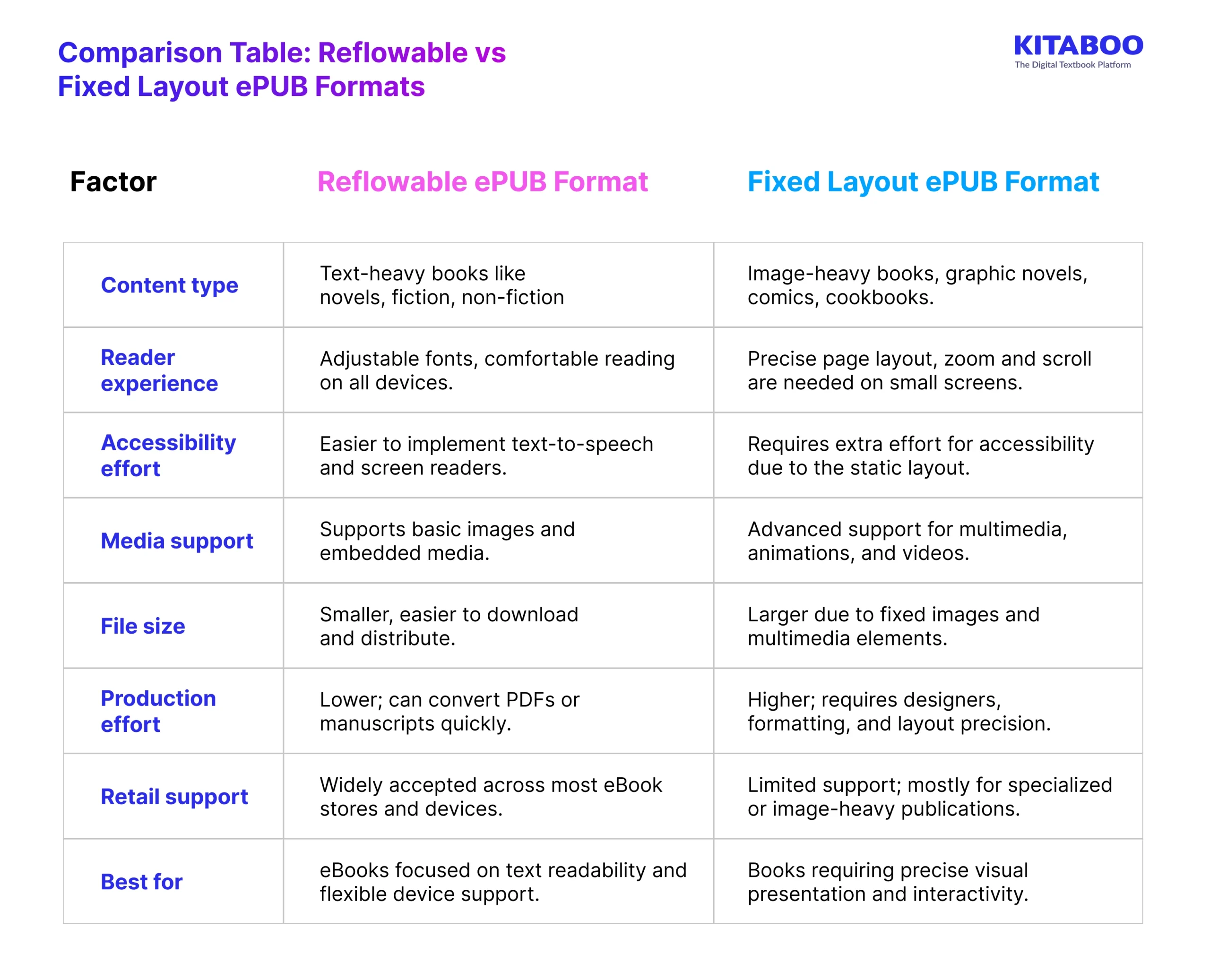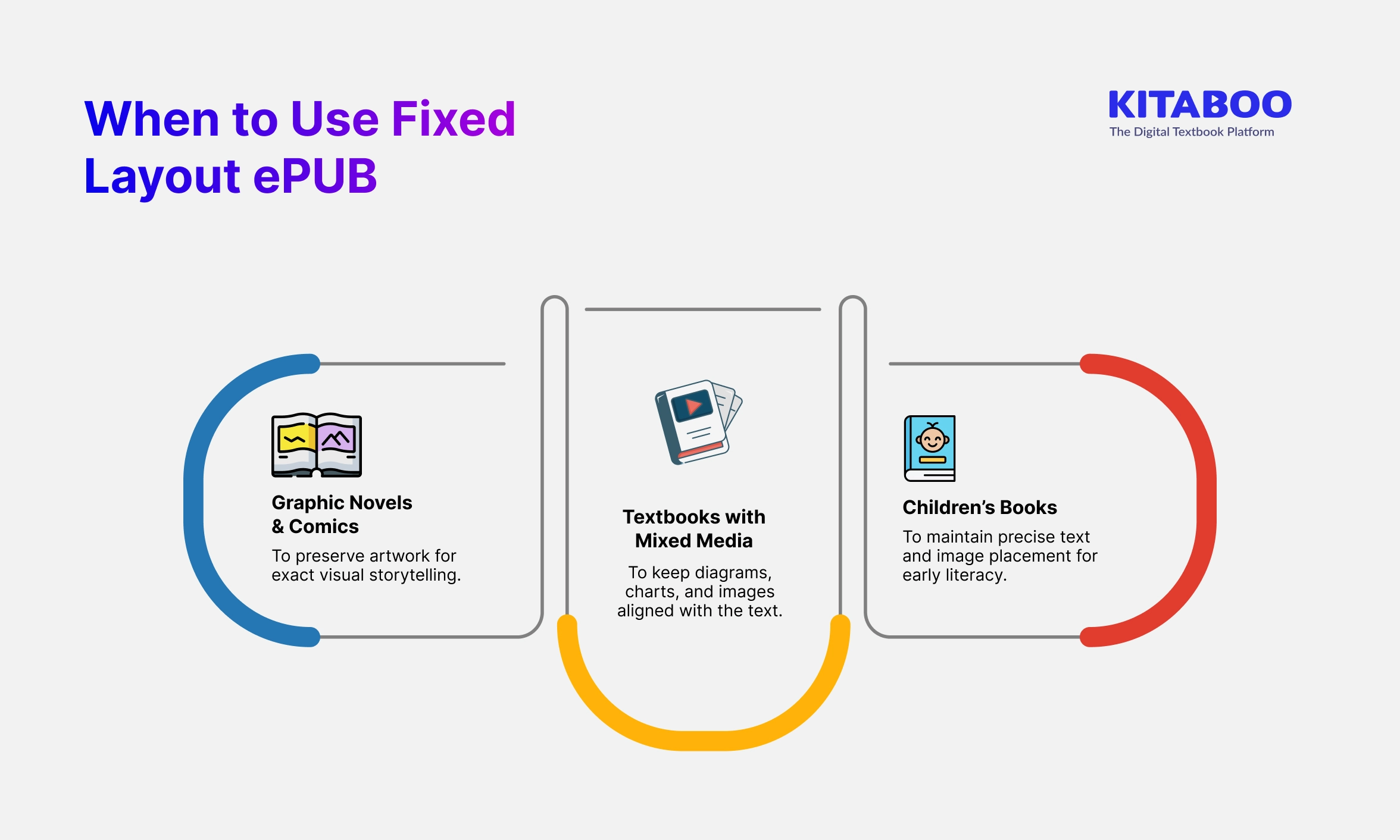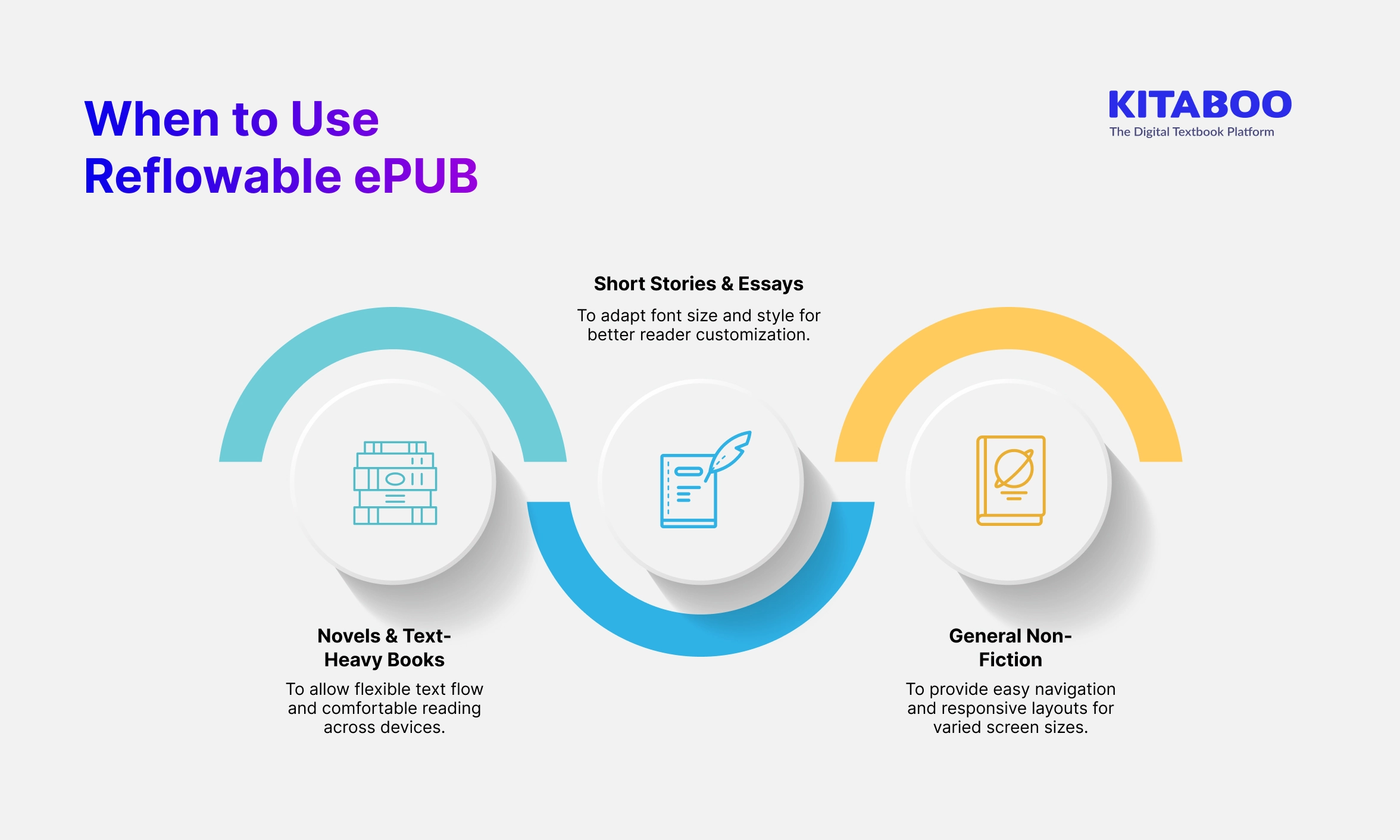
Reflowable vs Fixed Layout – Which is the Best Layout for your eBook
Summarize this blog with your favorite AI:
Reflowable vs Fixed Layout – Which is the Best Layout for your eBook – TL;DR
Choosing the right ePUB layout is essential for delivering a seamless reading experience. Reflowable ePUB advantages make it ideal for text-heavy books, offering flexible resizing and device compatibility.
Fixed layout EPUB benefits, on the other hand, ensure precise design and multimedia support for image-heavy or interactive books.
Understanding the differences between reflowable vs fixed layout ePUB helps authors choose wisely. Your choice affects readability, accessibility, production effort, and distribution across devices and platforms.
| Factor | Reflowable ePUB Format | Fixed Layout ePUB Format |
|---|---|---|
| Content type | Text-heavy books like novels, fiction, non-fiction. | Image-heavy books, graphic novels, comics, cookbooks. |
| Reader experience | Adjustable fonts, comfortable reading on all devices. | Precise page layout, zoom and scroll are needed on small screens. |
| Accessibility effort | Easier to implement text-to-speech and screen readers. | Requires extra effort for accessibility due to the static layout. |
| Media support | Supports basic images and embedded media. | Advanced support for multimedia, animations, and videos. |
| File size | Smaller, easier to download and distribute. | Larger due to fixed images and multimedia elements. |
| Production effort | Lower; can convert PDFs or manuscripts quickly. | Higher; requires designers, formatting, and layout precision. |
| Retail support | Widely accepted across most eBook stores and devices. | Limited support; mostly for specialized or image-heavy publications. |
| Best for | eBooks focused on text readability and flexible device support. | Books requiring precise visual presentation and interactivity. |
Digital content has transformed information consumption in ways one would have never imagined be it fixed layout ePUB version or reflowable one. Accessing and consuming content has seen a 360o flip in every industry, but nowhere is it more evident than in the publishing industry.
Check Our New Tool – Convert your Fixed PDF / InDesign to Dynamic Content – Instantly!
When it comes to eBooks, what according to you makes or breaks the deal? Is it the content or is it the appropriate use of appealing fonts or is it the attractive visuals? OR is it the crafty amalgamation of all three oriented most strategically? The layout design is as important as ad content creation and choosing fonts and color schemes. And the open secret for a well-designed layout lies in the orientation of its elements in relation to each other.
Also Read: Digital Publishing Platform for Associations and Societies
Table of Contents
- What is an eBook Layout?
- What is the Difference between Reflowable and Fixed eBooks?
- What is Reflowable Layout ePUB?
- What is Fixed Layout (FXL) ePUB?
- Readability of Content
- Ability to Change Fonts
- Device Support
- Suitable for Different Types of Books
- Interactivity
- Final Look of the eBook
- Content Reach
- Production Cost & File Size
- Accessibility Considerations
- Distribution & Reader Support
- Comparison Table: Reflowable vs Fixed Layout ePUB Formats
- When to Use Fixed Layout ePUB
- When to Use Reflowable ePUB
- How KITABOO Supports Both ePUB Types
- Conclusion
- FAQs
What is an eBook Layout?
Going by the definition, an eBook layout design is how the elements of your eBook are arranged and laid out. Artistically speaking, the eBook layout design is your way of appealing to your readers and attracting their subconscious to your content and eventually create a wow factor.
eBooks have surely thrown the market open to the widest possible audience. This only underscores the importance of choosing the most appropriate eBook layout for your content. You’ve got two layout formats to choose from – ePub Fixed Layout (FXL) vs Reflowable.
ePUB is one of the most widely used file formats for eBooks. Before you turn your manuscript or PDF into an eBook, you need to decide which layout would be appropriate for your content. A layout is the design and placement of the various elements in your eBook.
eBooks can be read in landscape or portrait mode. The orientation of the reading device depends on the user’s preference, but the flow or layout of the content is something that’s decided by the author or the publisher. There are mainly two types of layouts in eBooks- Reflowable layout and Fixed layout ePUB.
Suggested Read: Multilingual Support in Digital Learning: Expanding Your Association’s Global Reach
What is the Difference between Reflowable and Fixed eBooks?
The earlier version of ePUB could only convert eBooks into one standard layout- the reflowable format. The new ePUB3 version has brought a fixed layout into the picture. Publishers and authors now have to decide which format to choose at the time of conversion, based on the kind of content.
Also Read: What is eBook DRM and Why Do Publishers Need it?
Let us, through this blog post, try to weigh both the eBook layouts and understand which is better for your content.
What is Reflowable Layout ePUB?
In a reflowable layout, all the contents of the page adjust the orientation to fit into any screen size. ePUB reflowable layout is flexible and easily adapts to different mobile devices. Hence, it is the standard layout for most eBooks.
Related Read: How to Create Reflowable ePUB for Multiple Devices
What is Fixed Layout (FXL) ePUB?
In a fixed layout format, the content on the page remains static. Sometimes, ePUB fixed layout is necessary to keep the content and design at defined places on a particular page. Changing the alignment could either change the flow of reading or change the meaning of the content.
Let’s compare the two to understand the differences between both these eBook layouts –

Related Read: How to create a Fixed Layout ePUB3 file from a PDF
1. Readability of Content
In a reflowable layout, the text will always perfectly fit your screen. While reading, the user does not have to keep adjusting the page, providing a comfortable reading experience. This layout is used for text-heavy books, such as novels.
In a fixed layout ePUB, the contents of the page slide off the edge of the screen. It’s like a printed book. The size and position of the pictures and text must remain constant. Text and images are paginated and they don’t change no matter how big or small the screen size is. The user has to scroll and zoom, in order to read it comfortably.
2. Ability to Change Fonts
In reflowable layout, when you increase or decrease the font size, the line break changes and the rest of the text aligns itself accordingly. The freedom to change the font style and size lets the lines of text to expand and reflow.
Fixed layout ePUB does not allow the user to change font and text size. The user will have to zoom in and out, and scroll left and right to read the content. This type of content is not suitable for small screens. In a fixed layout ePUB, authors must ensure that they choose an easily readable font and keep the font size reasonably large so that users don’t have to strain their eyes.
3. Device Support
The reflowable layout is accepted by most eBook readers like Kindle, Apple iBooks, Nook and Kobo. Since ePUB is the standard format for eBook conversions and is openly available, it is supported by a lot of reader devices.
Some of the devices do not support fixed layout. For example, Amazon accepts fixed layout only for children’s illustrated books. At the moment, very few readers support the fixed layout in comparison to a reflowable layout.
4. Suitable for Different Types of Books
The reflowable ePUB format is mainly suited for text-only eBooks such as novels, fiction, non-fiction books, and books that does not have a lot of images or graphics. Since these books consist a lot of text content, they can be designed to realign as per different screen sizes. It gives the user a better reading experience.
Fixed layout is more suited for eBooks with a lot of images, graphs or charts. For example, illustrated children’s books, cookbooks, coffee-table books, graphic novels, comics, technical manuals. These books need to have a specific placement and pagination for the texts and images, hence fixed layout is more suited for picture-heavy books.
Since the placement of the content does not change, it is possible to add multi-column content. One can include double-page spreads and coloured backgrounds as well. Here’s How to Convert PDF to ePUB3 while Keeping the Format Intact.
Guide:
How to Automate PDF to
ePub3 Conversion
5. Interactivity
Novels and fiction books rarely have any images or graphics in them. So reflowable eBooks do not have any interactive features apart from the zoom, search and highlight options.
Fixed layout eBooks, on the other hand, have additional interactivities. One can include animations and videos in a fixed layout eBook. The text to speech feature can be added for users to listen to the eBook, this feature also helps people with visual impairment or a reading disability.
6. Final Look of the eBook
In a standard layout, the author can’t really predict how the eBook would look like on the user’s screen, unless he wants it published and tested on all possible devices before making it available for the user. The look of the page, the alignment of text etc., might change depending upon the size and orientation of the user’s device.
In a fixed layout, the author has full control over how he wants the finished product to look. The author can decide the final alignment of the contents of the page.
The author has complete control over the design and layout of every page, since the placement of the contents would not change irrespective of the device and screen size they are read upon.
7. Content Reach
Most of the operating platforms and devices support the reflowable layout. Hence, you would find that a majority of eBooks are designed and distributed in this format. Hence, eBooks with a reflowable layout have more distribution and a far wider reach.
Fixed layout ePUB does not have many takers as of today. But as ePUB develops, it is expected to gain more popularity and readership.
8. Production Cost & File Size
When evaluating reflowable vs fixed layout ePUB, production cost and file size are key considerations.
Reflowable ePUB files are generally lighter and less expensive to produce. Their flexible design makes them easier to create and distribute without making the file size too heavy.
The fixed layout ePUB benefits include precise placement of images and text. These benefits often come at a cost. These files are heavier, require more complex design work, and can lead to higher production expenses.
The choice between reflowable vs fixed layout ePUB depends on your publishing priorities. Decide whether you value efficiency or detailed visual presentation for your content.
9. Accessibility Considerations
Accessibility is another area where the differences between the two formats become clear.
Reflowable ePUBs are designed to adapt to different screen sizes and support features like text resizing and screen readers. This makes them one of the best ePUB formats for readers with visual impairments or other accessibility needs.
Fixed layout ePUBs, however, are more rigid. While they can include features like embedded audio or captions, ensuring full accessibility usually requires additional effort.
For authors and publishers focused on inclusivity, the reflowable ePUB advantages stand out strongly.
10. Distribution & Reader Support
Distribution reach and reader compatibility are critical factors when choosing between reflowable vs fixed layout ePUB formats.
Reflowable ePUBs are widely supported across devices, eReaders, and global eBook marketplaces. This broad compatibility makes them easier to distribute and ideal for reaching a large audience.
Fixed layout ePUB benefits are best realized in specific contexts. They work well for graphic-heavy books where layout accuracy is essential. However, not all platforms support fixed layouts equally.
Knowing when to use fixed layout ePUB helps ensure your book reaches the right readers without technical barriers.
Comparison Table: Reflowable vs Fixed Layout ePUB Formats
When to Use Fixed Layout ePUB
Understanding when to use fixed layout ePUB helps authors choose the right approach for their books. It ensures you select the best ePUB format for readers and content needs.
-
Graphic Novels and Comic Books Needing Exact Page Visuals
Fixed layout ePUB benefits are clear in graphic novels and comics. These books rely heavily on panel sequencing, artwork, and text placement for storytelling.
A fixed layout ensures every frame and caption remains exactly as intended, preserving the artistic flow. The consistency enhances the reading experience across devices.
This makes fixed layout one of the best ePUB formats for such highly visual publications.
-
Textbooks with Mixed Media (Images, Diagrams)
Educational content often includes charts, diagrams, and illustrations alongside text. A reflowable layout might disrupt these elements, creating confusion for readers.
Here, the Fixed layout ePUB benefits include consistent formatting and better integration of multimedia. This format ensures diagrams stay aligned with their related content.
This precision is invaluable for learning materials that demand clarity, accuracy, and structure control.
-
Children’s Books with Letter-Position Alignment
Children’s books rely heavily on visuals and text alignment to support early literacy. The Fixed layout ePUB benefits here include precise text placement and engaging, interactive features.
This format ensures each letter, word, or image stays in place. This stability helps children connect visuals with text and improve comprehension. It also lets publishers deliver beautifully designed, interactive books across devices.
Knowing when to use fixed layout ePUB ensures a delightful and effective reading experience for young readers.
When to Use Reflowable ePUB
Knowing reflowable ePUB advantages helps authors during the reflowable vs fixed layout ePUB debate. This format is often considered the best ePUB format for text-heavy content.
-
Novels and Fiction Books
For novels and fiction, reflowable ePUB advantages include easy text scaling and device compatibility. Readers can adjust font size and style for comfort.
This adaptability ensures consistent reading experiences on phones or tablets. Its flexibility makes it the best ePUB format for long-form, text-heavy stories. Authors choose this format to reach a broader audience.
-
Non-Fiction and Biographies
Non-fiction and biographies often prioritize content over visuals. Reflowable ePUB advantages ensure text flows naturally across screens, improving accessibility.
Readers can personalize their view without losing content structure or meaning. For authors, this format remains the best ePUB format to reach readers on any device. Its lower production cost makes it attractive for publishers.
-
Simple Textbooks or Guides
Guides or simple textbooks with minimal visuals benefit from a reflowable layout. Adaptability is one of the greatest reflowable ePUB advantages. The format simplifies distribution because it works across multiple platforms.
Publishers consider it the best ePUB format for content that focuses on information rather than design. It delivers readability while keeping costs low.
How KITABOO Supports Both ePUB Types
KITABOO offers powerful tools to create and distribute both fixed and reflowable ePUB formats. Publishers can design reflowable ePUB for text-heavy content, ensuring flexibility and device compatibility.
For visually rich books, KITABOO delivers fixed layout ePUB benefits like precise placement of images and interactive elements. The platform simplifies production by providing automation, design control, and support for multiple devices.
KITABOO’s SDK supports rendering both fixed-layout and reflowable ePUB. This makes it easier to distribute books across multiple devices and apps.
Publishers can use KITABOO’s PDF-to-reflowable conversion tool to transform static PDFs into responsive, dynamic content. This flexibility allows publishers to maintain a precise design for image-heavy books. They can also optimize accessibility for text-heavy content.
KITABOO makes choosing the best ePUB format easier by offering professional conversion, customization, and secure delivery.
Conclusion
In conclusion, the choice of eBook layout – reflowable or fixed – depends on the type of content being published. Reflowable layout is suited for text-heavy books such as novels, fiction, and non-fiction, while fixed layout is more suitable for eBooks with lots of images, charts or graphs such as illustrated children’s books, cookbooks, and graphic novels. Reflowable layout offers a comfortable reading experience and is accepted by most eBook readers. On the other hand, fixed layout provides greater control over the placement of the content and design at defined places on a particular page. Ultimately, the decision on which layout to choose should be based on the content and the target audience.
Based on the type of content, the author or the publisher must decide which layout they want the eBook to be published in. The main differentiating factor is that reflowable content changes its placement according to different screen sizes; while the fixed layout content does not.
So, if the author has a PDF or a manuscript which mainly consists of text, it’s better to go for a reflowable format. And if there are a lot of images and designs, a fixed layout ePUB will be more appropriate.
Contact our expert team now.
To know more, please write to us at contact@kitaboo.com.
Suggested Reads:
- Finding the Best ebook Creator | 10 Best eBook creation software
- How to Identify the Best eBook Conversion Services
- 9 Best Cross-Platform eBook Readers
- Best Practices in Publishing & Distributing eBooks at Scale
- Best eBook Publishing Strategies Every Publisher Must Know!
- How to Select the Best Digital Publishing Platform
- The Pros and Cons of DRM for eBooks: Is It Worth It
- ePub for Education
- eBook Distribution
- eBook Publishing
- Turn word Document into Book
- K12 Publishers
- Associations & Societies
- Trade Publishers
- Training Companies
- Content Aggregators
FAQs
Digital content in education refers to learning materials like videos, eBooks, and online courses delivered through technology.
Digital tools help bridge education gaps in rural areas by delivering lessons remotely and improving accessibility.
Digital content makes learning engaging, interactive, and accessible, improving knowledge retention and comprehension for students.
Challenges include internet access limitations, increased screen time, and distractions in non-traditional learning environments.
AI personalizes learning experiences, automates content creation, and offers adaptive feedback to enhance student success.
Immersive tools like AR and VR create realistic experiences, improving engagement and practical understanding.
Discover how a mobile-first training platform can help your organization.
KITABOO is a cloud-based platform to create, deliver & track mobile-first interactive training content.





